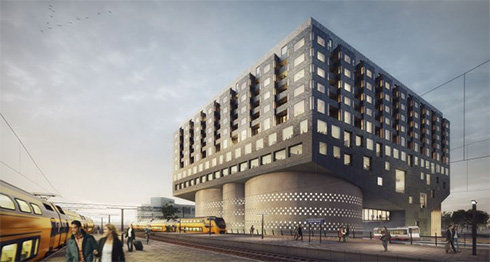Cities are increasingly constructing high-profile iconic buildings in order to put themselves on the map. Although this could be a good idea, you should first think carefully about what you want to achieve as a city by doing this, advises Wouter Jan Verheul of Urban Area Development (Real Estate & Housing).
His PhD thesis ‘City Icons. The emergence of image building projects between concept and concrete’ already appeared in 2012, but continues to attract attention. Wouter Jan Verheul is regularly invited by the media to reflect on current issues concerning large-scale urban projects. And Hans Busstra is filming the stories behind the projects from his thesis in a documentary to be shown this autumn.
After all, ‘iconography’ is a hot topic. And a good example of this is the new Rotterdam Central station that opened with a great fanfare. The ‘Gateway to Europe’ is promoting itself with its new station, also known as ‘Haaienbek’ (‘Shark’s mouth’), in an area it wants to transform into a high-quality CBD. Icons can function as catalysts for a neighbouring area, as in Rotterdam in the ‘Kop van Zuid’ district. “The expensive Erasmus Bridge was used there to entice market players to invest in the south bank,” explains Verheul. “And that's what the city is trying to repeat here.”
Every city is able to invent a good motive for creating ‘postcard architecture’. Enschede wanted to be more attractive for the well-educated with a ‘Nationaal Muziekkwartier’ (National Music Quarter). The city of Almere, which is often perceived as boring and modernistic, got none other than Rem Koolhaas to design a new iconic city centre, the ‘Stadshart’ (‘City Heart’). Many cities want to replicate the example set by Bilbao and Sydney, which put themselves on the map as cities of culture with the spectacular Guggenheim Museum and the Opera House respectively.
Unfortunately, the ‘flywheel effect’ used by city leaders to sell spectacular architecture often fails in its ambitions. The ‘Kasteel van Almere’ (Almere Castle), for example, looked like a good idea for enhancing the new town's identity through the construction of a historicist building. It was an utter failure: the intended entertainment venue was never completed and has since fallen into ruin. The spectacular ‘Bird’s Nest’ stadium in Beijing, which has been standing vacant since the 2008 Olympic Games, is a striking international example of the failed effects of an icon.
Are there rules of thumb with which an icon must comply? Firstly, Verheul indicates, an icon must be rooted socially and spatially in its environment in order to be successful. “Icons are not created on the drawing board. They need to be developed through a dialogue with residents and other parties involved.” In addition, city leaders need to formulate the specific urban identity to which an iconic building should contribute. After all, how can an icon achieve its desired aura if its symbolic value cannot even be explained?
The city projects described by Verheul in his book captured the imagination to such an extent that documentary maker Hans Busstra saw a great documentary in them. “Iconic building projects are usually approached one-sidedly by the media, almost always from the perspective of budget overruns or aesthetics,” according to Busstra. “Verheul's research goes a level deeper and establishes a conclusive link between these types of building and urban identity.”
Betoog & Beton is an independent Spiegel Film production, sponsored by the Creative Industries Fund NL. It is scheduled for completion in late 2014 and will be screened at various venues across the country.
Published: March 2014
More information
- Paper 'Stedelijke Iconen. het ontstaan van beeldbepalende projecten tussen betoog en beton' (Dutch only)
- Trailer documentary 'Betoog en Beton' (Dutch only)
